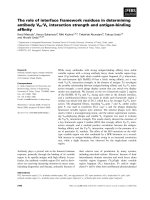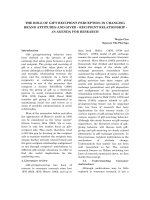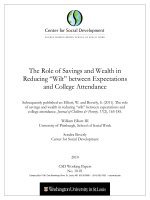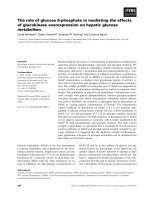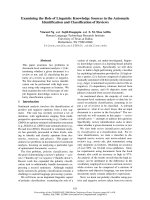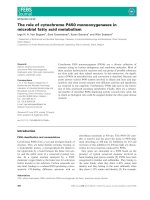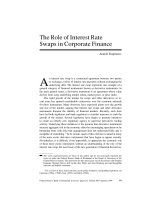the role of human resource systems in job
Bạn đang xem bản rút gọn của tài liệu. Xem và tải ngay bản đầy đủ của tài liệu tại đây (2.19 MB, 51 trang )
Cornell University ILR School
DigitalCommons@ILR
CAHRS Working Paper Series
Center for Advanced Human Resource Studies
(CAHRS)
5-1-1992
e Role of Human Resource Systems in Job
Choice Decisions
Robert D. Bretz Jr.
University of Notre Dame
Timothy A. Judge
Cornell University
Follow this and additional works at: hp://digitalcommons.ilr.cornell.edu/cahrswp
is Article is brought to you for free and open access by the Center for Advanced Human Resource Studies (CAHRS) at DigitalCommons@ILR. It
has been accepted for inclusion in CAHRS Working Paper Series by an authorized administrator of DigitalCommons@ILR. For more information,
please contact
e Role of Human Resource Systems in Job Choice Decisions
Abstract
Given that organizations make choices about how to manage their human resources, underlying information
about the organization is oen expressed or implied in the human resource systems that organizations
implement. is study proposes that information conveyed through human resource systems aects applicant
job choices, that particular systems will be more important to some people than others, and that job
acceptance will be inuenced by the degree to which individual characteristics match the content of the
system information presented. A policy-capturing design was used to assess the eects of human resource
systems within the context of other variables that past research has shown to signicantly inuence job
choices. Results suggested support for the importance of human resource systems in job choice decisions, and
further suggested that the t between individual characteristics and organizational seings described by the
systems in place may be particularly important determinants of job acceptance.
Keywords
CAHRS, ILR, center, human resource, studies, advance, job, choice, decision, manage, information,
organization, policy, design, acceptance
Comments
Suggested Citation
Bretz, R. D., Jr., & Judge, T. A. (1992). e role of human resource systems in job choice decisions (CAHRS
Working Paper #92-30). Ithaca, NY: Cornell University, School of Industrial and Labor Relations, Center for
Advanced Human Resource Studies.
hp://digitalcommons.ilr.cornell.edu/cahrswp/316
is article is available at DigitalCommons@ILR: hp://digitalcommons.ilr.cornell.edu/cahrswp/316
The Role of Human Resource Systems in Job Choice Decisions
Robert D. Bretz, Jr. and Timothy A. Judge
Center for Advanced Human Resource Studies
School of Industrial and Labor Relations
Cornell University
Working Paper # 92-30
This paper has not undergone formal review or approval of the faculty of the ILR School. It
is intended to make the results of Center research, conferences, and projects available to others
interested in human resource management in preliminary form to encourage discussion and
suggestions.
RUNNING HEAD: Human Resource Systems
1
The Role of Human Resource Systems in Job Choice Decisions
Robert D. Bretz, Jr. and Timothy A. Judge
Center for Advanced Human Resource Studies
School of Industrial and Labor Relations
Cornell University
RUNNING HEAD: Human Resource Systems
Human Resource Systems 2
Abstract
Given that organizations make choices about how to manage their human resources,
underlying information about the organization is often expressed or implied in the human
resource systems that organizations implement. This study proposes that information
conveyed through human resource systems affects applicant job choices, that particular
systems will be more important to some people than others, and that job acceptance will be
influenced by the degree to which individual characteristics match the content of the system
information presented. A policy-capturing design was used to assess the effects of human
resource systems within the context of other variables that past research has shown to
significantly influence job choices. Results suggested support for the importance of human
resource systems in job choice decisions, and further suggested that the fit between
individual characteristics and organizational settings described by the systems in place may
be particularly important determinants of job acceptance.
Human Resource Systems 3
The Role of Human Resource Systems in Job Choice Decisions
For several years staffing experts have been suggesting that an organization's human
resource systems might be instrumental in the staffing decisions made by organizations and
the job choice decisions made by applicants (e.g., Olian & Rynes, 1984; Rynes, 1992).
Although this thesis is endemic to staffing research in general, it is particularly salient and
explicit in discussions of strategic staffing and person-organization fit. Strategic staffing
may be described as recruiting and selection activities that are derived from a systematic
assessment of the organization's strategic objectives and needs (Butler, Ferris, & Napier,
1991). That is, strategic staffing activities are purportedly undertaken to procure long-term
human assets; not merely to fulfill immediate operational objectives (Lorange & Murphy,
1984; Miller, 1984). Similarly, person-organization fit addresses the suitability or propriety
of certain types of people in particular types of organizational environments, with the
assumption that this match has long-term implications for organizational effectiveness
(Schneider, 1987). Differences in human resource systems supposedly reflect the underlying
nature of organizations, and therefore, in the staffing context, provide the environmental
context for determinations of fit. This necessitates exploring the meaning of human resource
systems and applicant perceptions of person-organization fit.
Human Resource Systems
The term human resource systems can be used to refer to the collection of policies,
practices, and procedures that affect particular human resource functions (Bretz, 1988). For
example, reward (or compensation) systems include those activities that determine how pay
and other rewards are distributed to organizational members (Gerhart & Milkovich, in
press). Reward systems can be based on employee merit, longevity, or output (Milkovich &
Newman, 1987), or may be described by their focus on either the individual, the group, or
the organization (Staw, 1986). An individually-oriented reward system attempts to create
strong instrumentality linkages between performance and rewards by relying on the
Human Resource Systems 4
archetypical" merit system." A group-oriented reward system designs work and distributes
rewards on the basis of group performance. An organizationally-oriented system ties the
individual's rewards to the performance of the organization by relying heavily on profit
and/or gain sharing, bonuses, and stock options. Reward system characteristics reflect
fundamental differences in what the organization deems valuable, and how it chooses to
distribute resources among its members (Gomez-Mejia & Balkin, 1992).
Additionally, while mobility in organizations is often accompanied by increases in
compensation (Gerhart & Milkovich, 1989), the staffing system itself can have independent
motivating characteristics (Markham, Harlan, & Hackett, 1987). Mobility or career systems
describe mechanisms by which individuals move into, through, and out of organizations
(Rosenbaum, 1984). Sonnenfeld & Peiperl (1988) define career systems as "collections of
policies, priorities, and actions that organizations use to manage the flow of their members
into, through, and out of the organization over time" (p. 588). Turner (1960) described
mobility systems as either contest-oriented or sponsored-oriented. Under a contest norm,
upward mobility is the result of victory in a fair and open contest. Promotions are made on
the basis of recent performance. Therefore, those who excelled in the past must continue to
compete for further promotion and those who lost in prior rounds are not disadvantaged in
the current competition (Bretz & Dreher, 1988). In contrast, mobility under a sponsorship
norm relies on early identification of those possessing certain characteristics. This select
group is afforded different career opportunities than the non-sponsored cohort (Bretz &
Dreher, 1988). The most obvious example of sponsored mobility systems are organizational
"fast tracks" and internal promotion policies (Rosenbaum, 1984).
In addition to human resource systems demarcated by functional specialty, these
systems might also include sets of policies and practices that are endemic to the organization
and cut across functional boundaries. For example, work values represent a subset of social
values that suggest general patterns of behavior individuals ought to exhibit at work
Human Resource Systems 5
(Fallding, 1965; Rokeach, 1973). Recent research has revealed that achievement, concern
for others, honesty, and fairness are the most salient work values to most individuals
(Cornelius, Ullman, Meglino, Czajka, & McNeely, 1985; Ravlin & Meglino, 1987).
Although these values seem to be universally important, individuals express differences
regarding their relative importance, and appear to choose jobs based on the degree to which
organizational values match personal values (Judge & Bretz, 1992). Some past research has
indicated that fairness is the most important work value to individuals (Judge & Bretz,
1992). This suggests that the justice systems of the organization, or the degree to which
fairness is emphasized in organizational procedures and in the distribution of outcomes, is a
critical component of how an organization treats its workers (Folger & Greenberg, 1985;
Greenberg, 1990).
Similarly, individuals presumably differ in the degree to which work and family
obligations create conflicts. For example, the strength of a person's work ethic (Weber,
1958) may influence the level of work/family conflict a person experiences. The confluence
of demographic, legislative, and attitudinal changes suggest that work/family issues will be
of central importance in the future (Zedeck, 1992). The collection of policies regarding how
an organization deals with work/family issues might reasonably be thought of as a human
resource system. Differences in how organizations accommodate work/family issues are
likely to differentially affect job seekers (Friedman & Galinsky, 1992).
The above discussion suggests that human resource systems playa critical role in the
relationship between an employee and his or her organization. Thus, past research suggests
that some of the more critical dimensions along which a human resource system can be
classified relate to its compensation policies, its mobility system, the degree to which a
justice system is in place, and work/family policies. The degree to which these systems are
seen as important by individuals likely will influence the choices and decisions they make
about their work role membership.
Human Resource Systems 6
Strategic Staffing and Pre-Hire PerceJ>tions of Fit
To the extent that organizational strategic objectives drive the firm's human resource
systems, organizations reveal important contextual information in the systems they choose to
implement. Therefore, knowledge of the organization's human resource systems should
impact job seekers' decision-making process. However, although many have theorized about
both the variability and propriety of human resource systems, little is known about how job
applicants interpret human resource system differences between organizations.
Using the Miles and Snow (1978) typologies, Olian and Rynes (1984) proposed that
" different recruitment and selection practices attract different types of individuals into
organizations" (p. 170-171). They suggested that in recruiting, Defender-type organizations
would emphasize tight organizational control, a concern for efficiency of process, well-
defined internal promotion ladders, and a commitment to employee training and
development. These organizational characteristics were hypothesized to attract individuals
with high needs for security and structure and low tolerance for ambiguity. Likewise,
Prospector-type organizations were expected to emphasize dynamic work processes, more
concern over output than process, and a commitment to innovation. Reward distribution and
staffing decisions would reflect a focus on recent individual accomplishments. These
organizational characteristics were expected to attract individuals with a propensity for risk-
taking.
Similarly, Sonnenfeld & Peiperl (1988) suggested that organizations that hire at entry
levels and use mobility systems based on group accomplishment ("Clubs") would be more
attractive to individuals who favor job security over rapid advancement. Those that hire at
all levels and base mobility on individual achievement ("Baseball Teams") should attract
highly motivated, confident, risk-taking individuals. Finally, those that hire only at entry
level and base mobility on individual accomplishment ("Academies") should appeal most to
those with long-term focus and strong organizational commitment. The taxonomies
Human Resource Systems 7
described above are conceptually appealing, yet we are unaware of any studies that have
empirically examined whether these issues actually are emphasized by organizations best
characterized by the respective typologies, how potential applicants react to this information,
or what applicants infer about the organization on the basis of this information.
Early attempts to describe pre-hire perceptions of fit mainly relied on theories of
vocational choice (e.g., Holland, 1966; Super, 1953). For example, Tom (1971) extended
Super's (1953) perspective of vocational choice to the organizational context by asking
students to describe themselves and two organizations: one they would most prefer to work
for and one they would least prefer to work for. He found more similarity between the
individual's description of himself and the most preferred organization than there was
between the self description and that of the least preferred organization. Similarly, Burke &
Deszca (1982) investigated the relationship between Type A behavior and preferences for
particular organizational climates. Type A behavior scores were related to preferences for
working environments characterized by high performance standards, spontaneity, ambiguity,
and toughness. Since the personality attributes describing Type A individuals include
ambition, competitiveness, need for achievement, and impatience, it appears that the drive
for congruence in occupational contexts extends to organizational preference as well.
The extension of the vocational choice literature to the organizational choice context
suggests that accepted theories of person-environment fit are relevant in the organizational
choice context and appear to explain some of the variance in organizational choice decisions.
Recent examination of person-organization fit has focused on fit at the post-hire stage (e.g.,
Blau, 1987; Caldwell & O'Reilly, 1990; French, Caplan & Harrison, 1982; Kulik, Oldham
& Hackman, 1987; Meglino, Ravlin & Adkins, 1989; Moos, 1987; O'Reilly, Chatman &
Caldwell, 1991; Rounds, Dawis & Lofquist, 1987). However, a few studies have attempted
to assess the degree to which perceived person-organization fit affects job choice behavior.
For example, Bretz, Ash, & Dreher (1989) found some support for the hypothesis that the
Human Resource Systems 8
valence of an organization's reward system to an individual depended on the personality of
the individual. Similarly, Judge and Bretz (1992) found that organizational values were an
important determinant of job choice and that individuals preferred jobs in organizations
which displayed value preferences similar to their own. Finally, Rynes, Bretz, and Gerhart
(1991) content analyzed in-depth interviews with job seekers and concluded that applicants
assess fit on the basis of job characteristics, organizational practices, recruiter attributes,
and recruiting process activities.
Thus, it seems that applicants do form judgments about the desirability of particular
organizations on the basis of at least some of its human resource systems. Despite this
research, however, the assessment of organizational fit by job applicants remains largely a
mystery. Although we have an indication that applicants consider reward systems, mobility
systems, and value systems when forming opinions about the relative attractiveness of
organizations, we do not know the weight that is placed on these types of variables, or the
degree to which individual differences interact with these variables to influence job choice
behavior. The current study is an attempt to directly assess these issues in the context of
other variables that are known to affect job choices.
Hypotheses
Within-Subjects
A significant body of prior research has suggested that pay level and promotional
opportunities affect job choices (Rynes, 1992; Rynes & Lawler, 1983; Rynes, Schwab, &
Heneman, 1983; Schwab, Rynes, & Aldag, 1987). In fact, Rynes et al. (1983) concluded
that pecuniary attributes were so important in the job choice process that the effects of
nonpecuniary attributes could not be interpreted in their absence. Moreover, Locke (1976)
suggested that for most people, the desire for certain job attributes, like pay and promotions,
was linear because most people cannot get "too much" of these things. One reason for this
Human Resource Systems 9
may be that they can be applied to fulfill a wide range of needs. Consistent with this prior
research we hypothesized that:
HI:
Individuals will be more likely to accept jobs with higher than average salaries
than they will be to accept jobs with lower than average salaries.
H2: Individuals will be more likely to accept jobs where the promotional
opportunities are relatively high than they will be to accept jobs where the
promotional opportunities are relatively low.
Rynes (1992) lamented the fact that while a great deal has been learned about
recruiters, recruitment sources, and realistic job previews, recruitment research has
neglected other fundamental aspects of jobs and organizations that might affect job choice
decisions. One of the neglected areas are vacancy characteristics, which represent
distinguishing environmental or contextual characteristics that describe the job or
organization. Two primary objections to the inclusion of vacancy characteristics in
recruiting research have been offered. First, these types of characteristics may have their
greatest impact on retention and job satisfaction and should therefore be studied in those
contexts. Second, it may be of limited usefulness to understand the effect of these attributes
in the recruiting context since employers would be generally unwilling to make broad-based
changes in the organizational systems they represent (McEvoy & Cascio, 1985; Miceli,
1986; Rynes, 1992). These objections, however, may be less cogent today than in the past.
Because current and projected labor market trends are necessitating a shift from a
"screening" to an "attracting" mode for many organizations (Rynes & Barber, 1990),
information that differentiates an organization from others is likely to affect job choices.
Moreover, information that creates a positive impression of the organization and
distinguishes it from other organizations is likely to significantly improve its ability to attract
applicants. It is also not clear that all vacancy characteristics are expensive or difficult to
modify in order to attract applicants. One vacancy characteristic that has become more
Human Resource Systems 10
salient of late are policies to accommodate family needs and reduce their interference with
work activities. Rynes (1992) argues that work/family policies may influence job choices,
and contrary to the assertions regarding problems in studying vacancy characteristics, holds
that:
For example, provision of flextime or on-site day care even at the employee's
expense might yield high returns in terms of attraction and retention, because such
nonstandard benefits more clearly distinguish an employer from its competitors.
Similarly, there are several benefits that might be used only by a subset of the
employee populations (and hence be relatively inexpensive), but that might have
substantial effects on an organization's image as a "good place to work" (e.g.,
educational benefits or sick child day care). (p. 433)
It is also true that career expectations are becoming less significant indicators of
success in many individual's lives, and that many family-based influences are providing an
increasing sense of fulfillment for many people (Greenhaus & Beutell, 1985; Kanter, 1977).
Moreover, over 40% of the labor force consists of members of dual-income households
(Zedeck, 1992). Therefore, since the work/family issue is becoming increasingly important
and potentially offers recruiting advantages to organizations that exploit it properly, we
hypothesized that:
H3:
Individuals will be more likely to accept jobs in organizations with expressed
concern for balancing work and family issues than they will be to accept jobs
in organizations in which the importance placed on these issues is unknown.
Expectancy theory considers the attractiveness of alternative jobs as a function of the
perceived instrumentalities and valences associated with each of the alternatives (Vroom,
1964). Job opportunities that are considered most attractive will be those in which the
applicant believes that his/her performance will lead to positively valent outcomes. Human
resource system information that creates stronger instrumentality linkages should lead to
Human Resource Systems 11
higher levels of attractiveness. Individually-oriented reward systems should create stronger
instrumentalities than group-oriented reward systems because individual contribution and
accountability are clear. Because individually-oriented reward systems create explicit
instrumentalities between what are assumed to be positively valent rewards and individual
performance, these type of reward systems should be more attractive to job applicants.
Furthermore, American society has often been described as individualistic (as opposed to
collectivistic) in its orientation. This is evidenced by the fact that when compared to
workers in other countries, workers in the United States place a high value on individual
work goals such as high pay and a lower value on group outcomes such as good
interpersonal relations with co-workers (MOW International Research Team, 1987). Thus,
while for some individuals group- or team-based reward systems may be attractive, for most
individuals they will be less attractive due to their perceived lower probability of leading to
work role rewards, and because of the individualism extant in American culture. For the
reasons above we hypothesized that:
H4: Individuals will be more likely to accept jobs in organizations where rewards
are distributed on the basis of individual merit than they will be to accept jobs
in organizations where rewards are distributed on the basis of group output.
Moreover, contest mobility systems also make valent outcomes (promotions) contingent on
individual performance. Therefore, instrumentalities also should be stronger in contest, as
opposed to sponsored, mobility systems. Furthermore, the social values of Americans may
again be relevant here, where societal norms dictate that equal opportunities for advancement
be available to all (Rosenbaum, 1984). Therefore, we hypothesized that:
H5:
Individuals will be more likely to accept jobs in organizations which rely on
contest mobility norms than they will be to accept jobs in organizations with
sponsored mobility norms.
Human Resource Systems 12
Locke (1976) defined needs as "objective requirements of an organism's survival and
well-being" (p. 1303). Needs exist whether or not a person actively desires their
fulfillment, and irrespective of what the person wants. Values, on the other hand, are
enduring perspectives of right and wrong, based upon what the person wants (Locke, 1976;
Rand, 1966). Work values have been shown to be related to the job choices people make
(Judge & Bretz, 1992), the way people feel about their work (Spence, 1985), the way they
behave on the job (England, 1967, 1975), and their overall job satisfaction (Locke, 1976;
Meglino et al., 1989). Because work values are generally considered to be universally
desirable, organizational systems that encourage or insure commonly held values should be
preferable to organizational environments that are contrary to or ignore such values. In fact,
it has been shown that job satisfaction and intention to turnover are significantly related to
perceptions of justice (Alexander & Ruderman, 1987), and that individual's impressions of
organizations are strongly affected by perceptions of justice (Lind & Tyler, 1988).
Researchers have made a distinction between distributive justice (the fairness of ends or
outcomes achieved) and procedural justice (the fairness of means used to achieve those
ends) (Greenberg , 1987). The importance of distributive justice to individuals can be
explained by the "self-interest model," which suggests that distributive justice is desired
because it allows individuals to exert control over their own outcomes (Lind & Tyler, 1988).
On the other hand, procedural justice may be important to individuals because individuals
desire "process control," or the ability to influence the process of outcome attainment
(Greenberg, 1990; Lind & Tyler, 1988; Tyler, 1987). Thus, explicit policies reaffirming
that procedural and distributive justice are key elements of the organization's culture, and
are likely to be perceived favorably by most individuals (Greenberg, 1990). Therefore we
hypothesize that:
Human Resource Systems 13
H6a: Individuals will be more likely to accept jobs in organizations with expressed
policies to insure procedural justice than they will be to accept jobs in
organizations in which these policies are unknown.
H6b: Individuals will be more likely to accept jobs in organizations with expressed
policies to insure distributive justice than they will be to accept jobs in
organizations in which these policies are unknown.
Fit-Based Interactions
In addition to the main effects hypothesized for the human resource system attributes,
we also expected that individual differences between applicants would interact with the
system characteristics to affect job choices. Organizations tend to differentiate themselves
on the bases of what is rewarded (both formally and informally) and how rewards are
distributed (Gerhart & Milkovich, 1990). Individually-oriented merit systems should be
most attractive to individuals who prefer to work independently of others while group-based
reward distribution systems should be preferred by individuals who are predisposed to work
in cooperative settings (Bretz, 1988). Bretz et al. (1989) originally proposed that
individually-oriented reward systems would be preferred by applicants with high need for
achievement (nAch), and group-oriented reward systems would be preferred by applicants
with high need for affiliation (nAff). However, instruments for measuring these needs were
not specifically designed for work setting applications, and therefore may have limited
applicability. Rather, questions that directly assess the applicant's preference for individual
versus group-based work may be better indicators of reward system preference (Bretz, 1988;
Bretz et al., 1989). Therefore we hypothesized that:
H7: Individuals characterized by a preference for individual work and contribution
will be more likely than applicants characterized by a preference for team-
based work and contribution to accept jobs in organizations with individually-
oriented reward systems.
Human Resource Systems 14
Sponsored mobility systems describe a situation in which the future elite are chosen
by the established elite, on the basis of predetermined criteria. Those who do not possess
the distinguishing characteristics cannot earn them through any amount of skill or effort
(Turner, 1960). Because the future elite are identified early in their careers and "sponsored"
into elite status, in many ways their career success is beyond their control. Conversely,
contest mobility systems never really bestow elite status and require repeated competitions
for promotions and reaffirmations of one's ability. In this sense, one's career progression is
completely determined by one's own ability and effort vis-a-vis others in the cohort.
Internal locus of control describes individuals who tend to believe that they have significant
control over what happens to them, and external locus of control describes individuals who
tend to believe that the things that happen to them are caused by events beyond their control
(Rotter, 1966). Because contest mobility systems place one's career progression squarely on
one's own shoulders, and sponsored mobility systems effectively remove direct control over
career progression, we hypothesized that:
H8: Individuals with high internal locus of control will be more likely than those
with low internal locus of control to accept jobs in organizations with contest
mobility systems.
Although expressed policies for balancing work and family issues may indicate that
an organization is a good place to work (Rynes, 1992), it seems reasonable that these
policies would be more important to applicants with higher levels of perceived work/family
conflict, because they are more likely to have an immediate need for these accommodations
and therefore should prefer organizations which offer them. Furthermore, those who do not
presently experience work/family conflict but believe it will be an important issue for them
in the future also should value work-family policies. Therefore, we hypothesized that:
Human Resource Systems 15
H9: Individuals experiencing higher levels of work/family conflict will be more
likely than other applicants to accept jobs in organizations that have expressed
policies for accommodating work/family issues.
It has been demonstrated that individuals make job choices that are consistent with
value-laden goals (Vroom, 1966). Because organizational concern for procedural and
distributive justice is conceptually similar to "fairness," and value intensity affects the
amount or degree of something an individual wants (Locke, 1976; Rand, 1966), it is
reasonable to expect that individuals who value fairness will be motivated to accept a job in
an organization which emphasizes fairness. Thus, consistent with person-environment
interactionism, it is quite possible that attributes of the organization (in this case justice
systems) interact with attributes of the individual (in this case fairness value orientation) in
explaining attitudes and behaviors (in this case job choice decisions). In fact, Judge and
Bretz (1992) demonstrated that individuals were more likely to choose jobs whose value
content was similar to their own value orientation. Procedural and distributive aspects of
justice should be valent to individuals who value fairness because these individuals should be
concerned with the equity of outcomes and the means through which the outcomes are
achieved. Based on the above reasoning, we hypothesized that:
HlO: Individuals who are fairness value dominant will be more likely than other
applicants to accept jobs in organizations that express concern for (a)
procedural justice and (b) distributive justice.
Method
Pilot Study
Students interviewing for jobs were surveyed to identify the non-system factors most
important in individuals' job choice decisions. They were asked to rank (1 = most
important, 5 = least important) five different characteristics of jobs that had been identified
by past research as influential in job choice decisions (Rynes & Lawler, 1983; Rynes et al.,
Human Resource Systems 16
1983; Schwab, Rynes, & Aldag, 1987). The five factors were salary level, advancement
potential, geographic location, type of work, and type of organization. Twenty-eight
students completed surveys. To control for social desirability bias (Jurgensen, 1978),
individuals were asked to rank the importance of these factors according to how they thought
others perceived them. The mean (M) and standard deviation (SID of the ranks for the 5
factors were: type of work (M = 1.96,m = 1.29); salary level (M = 2.50, m = 1.11);
advancement potential (M = 2.86, m = 0.85); type of organization (M = 3.29, m =
1.54); and geographic location (M = 4.29, SD = 1.01). The mean ranks for geographic
location and type of organization were significantly lower than all other factors, except that
the difference between advancement potential and type of organization was not significant.
Because type of work desired exhibited little variation in our sample, salary level and
promotion opportunities were chosen as the non-system factors to include in this study.
These factors also offer the advantage of having previously been shown to be among the
most important determinants of job choices (Rynes & Lawler, 1983; Rynes et al., 1983;
Schwab, Rynes, & Aldag, 1987).
Settin~. Subjects, and Procedure
Surveys were administered to students in several upper-level human resources courses
at two major U.S. universities in the Midwest and Northeast. Participation was voluntary
and anonymity of responses was assured. Seventy-six students were eligible to participate
and 65 surveys were returned, yielding a response rate of 86%. Age of the respondents
ranged from 20 to 39 years, with the average age equal to 24.5 years <m = 3.8 years).
Eighty-two percent of the respondents were white, and 66% were men. Previous job
experience ranged from no prior experience to 21 years experience; the average respondent
reported an average experience level of 2.4 years <m = 3.8 years). Fifteen percent of
respondents were married. For those who were married, 78 % of their spouses worked
outside the home (44% worked in professional positions). The average working spouse
Human Resource Systems 17
worked 35.5 hours per week (£Q = 17.9 hours). Thirteen percent of respondents were
undergraduates, while 87% were graduate students. Thirty-one percent of the respondents
attended the Midwest University while 69 % attended the Northeast University. Grade point
average (GPA) of respondents ranged from 2.4 to 4.0, with an average of 3.4 (SD = 0.35).
Fifty-two percent of the respondents were currently interviewing for jobs, with the rest of
the students expected to interview within a year. Twenty-eight percent of the respondents
perceived many employment opportunities, while 51 % perceived some alternatives, and 21 %
perceived few or no employment alternatives.
Research Desien
We used a mixed experimental design which incorporated both within-subjects and
between-subjects components (Keppel, 1982). The within-subjects design permits inferences
to be drawn about the relative importance of particular factors that individuals use to make
decisions. This element of the design is referred to as policy capturing and has been used to
study decision making processes in many organizational contexts, including job choice
decisions (Arnold, 1981; Feldman & Arnold, 1978; Judge & Bretz, 1992; Rynes & Lawler,
1983; Rynes et al., 1983; Zedeck, 1977), disciplinary decisions (Klaas & Wheeler, 1990),
judgments of task importance (Sanchez & Levine, 1989), managerial pay raise decisions
(Sherer, Schwab, & Heneman, 1987), and judgments of sexual harassment (York, 1989).
The within-subject factors used in the present study included those that have been
shown by previous research to have an effect on job preferences (salary level and
promotional opportunities), and several human resource systems hypothesized to affect job
choices (reward systems, mobility systems, justice systems, and work-family systems).
Because non-pecuniary aspects of job choice may be interpretable only when pecuniary
attributes are accurately represented (Rynes et al., 1983), the manipulated values for pay and
promotional opportunities were derived from placement office data and reflected actual
market conditions that the subjects would face in a real job choice. Since salaries for
Human Resource Systems 18
undergraduates and graduate students varied, it was necessary to indicate different salary
figures for the undergraduate and graduate surveys. The salary levels also differed between
the Midwest and Northeast universities, so separate figures were provided in these surveys.
The two levels of salary represented the 75th and the 25th percentile of offers that were
currently being made to graduates of these degree programs. The two levels of promotional
opportunities were one promotion in four years (low) and two promotions in four years
(high), and again were representative of the actual conditions these graduates were likely to
experience.
Two levels of reward system differences were used. Individually-oriented reward
systems were described as those in which "yearly salary increases are determined by your
individual productivity." Alternatively, group-oriented reward systems were described as
those in which "yearly salary increases are determined by your work ~roup's productivity."
Two levels of mobility systems were used. Contest mobility systems were described as
those in which" all employees compete for promotions on the basis of their recent
performance, regardless of their historical accomplishments." Alternatively, sponsored
mobility systems were described as those in which "high potential employees are placed on
the 'fast-track' and have promotional opportunities that are generally unavailable to other
employees." Three levels of justice system differences were used. Justice system
differences were expressed as procedurally just ("employees are assured of fair treatment in
all human resource procedures"), or distributively just ("employees are assured that
outcomes and rewards are distributed fairly"). Alternatively, since it would be unreasonable
to expect subjects to express interest in organizations that are overtly unfair, and it is
unlikely that such information would be conveyed to job applicants, the third level of justice
system was represented by making no reference to the justice component. Finally, two
levels of work/family issues were used. The organization was either described as having
Human Resource Systems 19
"implemented policies that promote a balance between work and family life (e.g., day-care,
parenta11eave, flexitime, etc.)" or no mention was made of work/family issues.
The six within-subjects independent variables were completely crossed so that the
independent effects of each factor could be assessed. This resulted in 96 (2 x 2 x 2 x 2 x 2
x 3) scenarios which contained all possible combinations of the independent variables. The
order in which the factors appeared in the scenarios was randomized. An example of a
scenario is provided below.
This organization has implemented policies that promote a balance between
work and family life (e.g., day-care, parenta1leave, flexitime, etc.). The
starting salary for this job is $35,000. Employees are assured that outcomes
and rewards are distributed fairly. By the fourth year, the average graduate
has received 1 promotion. All employees compete for promotions on the
basis of their recent performance, regardless of their historical
accomplishments. Yearly salary increases are determined by your individual
productivity.
The dependent variable was the probability of accepting a job offer with the above
characteristics if such an offer were made. It was operationalized in this manner: "Indicate
the extent to which you would likely accept an offer possessing the above characteristics. "
Subjects responded to a 7-point Likert scale anchored by 1 = highly unlikely to 7 = highly
likely.
Between-Subjects Measures
Inter-individual differences based on individual attributes were assessed using the
between-subjects part of the design. In order to control for possible consistency or priming
effects (Salancik & Pfeffer, 1978), the survey order was mixed such that one-half of the
subjects completed the between-subjects material first, and one-half of the subjects completed
the within-subjects material first. Due to the length of the within-subjects part of the
Human Resource Systems 20
survey, it was necessary to keep the between-subjects portion as brief as possible.
Therefore, the shortest possible measures were used that would still yield a valid measure of
the constructs. Description of the between-subjects measures follows.
Team orientation. Preference for team-based reward contingencies was assessed with
a two-item scale which included the items (1) Members of a team should get the same
rewards, and (2) If some team members contribute more, they should get more in return.
Subjects responded by indicating that they thought the statement was either "true" or "false".
The coefficient alpha estimate for this measure was .77.
Locus of control. Locus of control was measured using five items from Rotter's
locus of control scale (Rotter, 1966). The items we used included (1) Without the right
breaks one cannot perform well on the job, (2) Many of the unhappy things in people's lives
are partly due to bad luck, (3) In my case getting what I want has little to do with luck, (4)
Who gets promoted often depends on who was lucky enough to be in the right place first,
and (5) Most people don't realize the extent to which what happens on the job is controlled
by accidental happenings. Coefficient alpha for the 5-item scale was .69.
Work/family conflict. Work/family conflict was measured using three items derived
from existing work/family conflict scales (Frone, Russell, & Cooper, 1992; Gutek, Searle,
& Klepa, 1991). These items included (1) My working life does (or I think my working life
will) interfere with my family life, (2) To "get ahead" I will have to neglect or postpone
some family duties or obligations, and (3) A person must choose to emphasize either their
work or their family life; you can't have it all. Subjects responded using a five-point Likert
scale (1 = strongly agree, 5 = strongly disagree). Coefficient alpha for the 3-item scale
was .60.
Fairness value dominance. Work values were assessed by the Comparative Emphasis
Scale (CBS), a survey developed and tested by Ravlin and Meglino (1987), Meglino et al.
(1989), and Ravlin and Meglino (1989). The values represented in the CBS were chosen
Human Resource Systems 21
from a set of many possible work values and appear to be the most salient and important
values to many individuals. The CBS presents 12 statements describing each of the four
values. These 48 statements are divided into pairs such that a statement representing each of
the four values is paired with each other value four times. For each pair, individuals are
asked to check which value they feel should be emphasized most in their own behavior.
Each of the four comparison replications was randomized in order and in the value that
appeared first in each pair. The emphasis on what the individual should or ought to display
is consistent with most conceptualizations of social values (Rokeach, 1973). The result
yields a purely ipsative measure of values (Le., which values are most important to each
individual relative to other values they consider). Fairness value dominance was determined
by the number of times an individual chose fairness over the other value in the pair. For
example, an individual who chose fairness over the other values 11 times would have a
greater fairness value dominance than someone who chose fairness over the other values 10
or fewer times.
Other variables. Questions concerning gender, race, age, marital status, spouse's
employment status, number and age of dependents, university and degree program attended,
grade-point average (GPA), number of years of work experience, perceived labor market
alternatives (1 = no alternatives, 5 = many alternatives), and estimated time to beginning
their job search (1 = currently interviewing, 5 = will not interview for more than a year)
were assessed from individual questions on the survey.
Analyses
Between-Subiects Analysis
The effects of the within-subjects factors, the between-subjects factors, and the
hypothesized interactions were examined using multiple regression analysis. Because the
policy-capturing design does not generate independent observations, estimates are susceptible
to autocorrelation. Thus, the regression parameters were estimated using generalized least
Human Resource Systems 22
squares (Hanushek & Jackson, 1977). To control for perceived differences in the
attractiveness of the job offers associated with university attended or degree program, three
dummy variables were formed from the four combinations of degree program (undergraduate
or graduate) and university (Midwest or Northeast). Undergraduates served as the excluded
group in the analysis. Perceived employment opportunities (1 = no perceived alternatives,
5 = many perceived alternatives), and estimated time from present that the respondent
intended to begin his or her job search (1 = interviewing now, 5 = more than a year) were
also used to control for the possibility that attractiveness of the offers was affected by
perceived opportunity or salience of the exercise.
Within-Subjects Analyses
The effects of the six independent variables on job choice decisions was assessed
using multiple regression analysis. Orthogonal contrast coding was used (Cohen & Cohen,
1983). One regression equation was calculated for each subject.
We also used a hierarchical clustering procedure to examine the degree to which
human resource systems are differentially important in job choice decisions to different types
of individuals. Ward's (1963) procedure was used as the clustering method because research
has suggested that Ward's procedure performs at least as well as any other clustering
method (Milligan, 1980). The procedure used as input the standardized regression weights
of the six within-subjects factors for each of the 65 subjects. It then iteratively combined
these weights and computed an error index based on the sum of the squared deviations
between each beta weight for each pair of individuals, divided by the number of individuals
in the group. The clusters consisted of those individuals who, when combined together,
generated the lowest squared deviation (the least error).
For example, the procedure began by forming 64 groups from the 65 subjects by
combining the two individuals who generated the smallest summed squared deviation
between their six beta weights. The procedure continued until all individuals were combined


